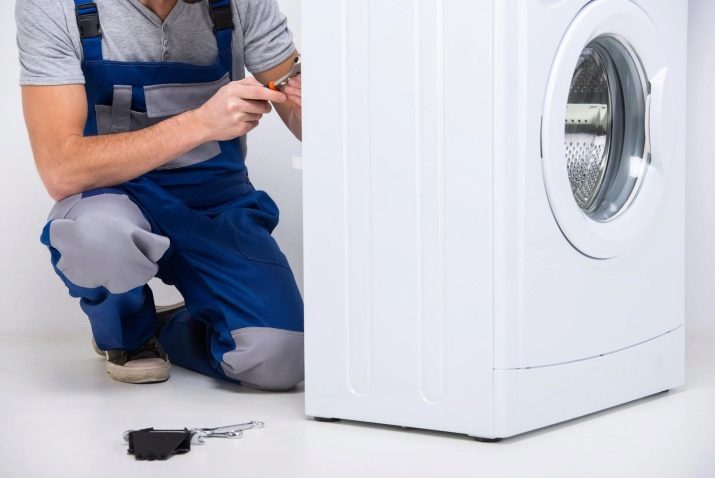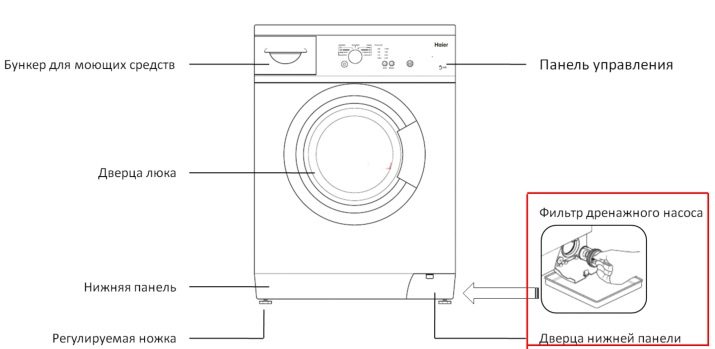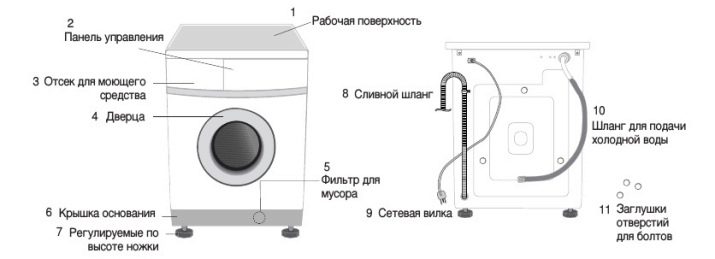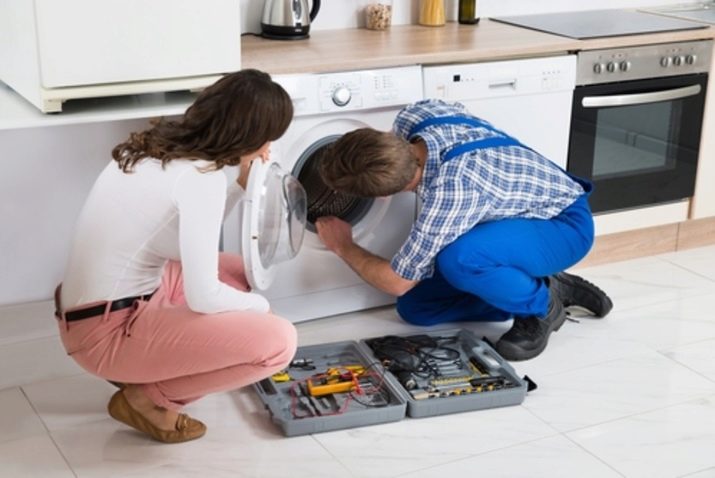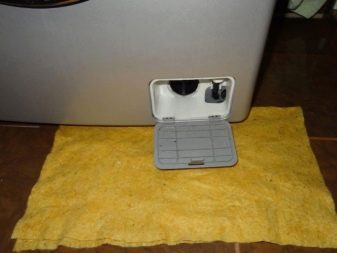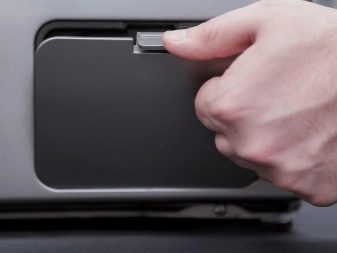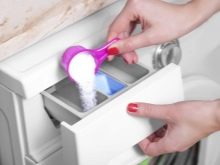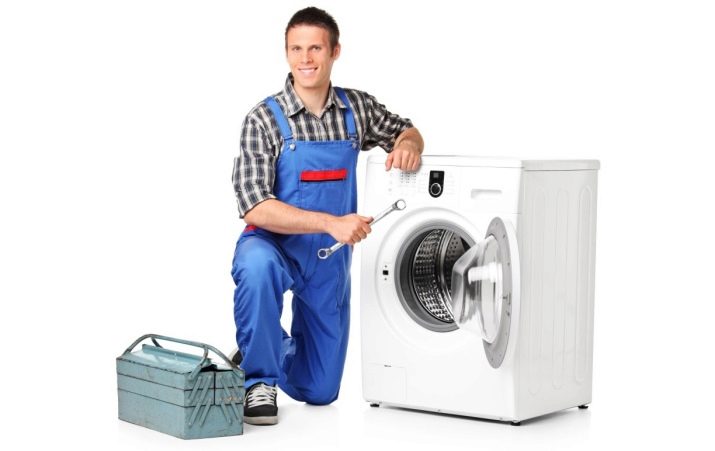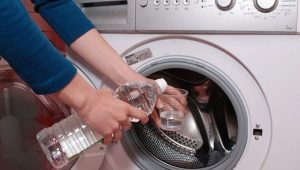How to clean the drain filter in the washing machine?
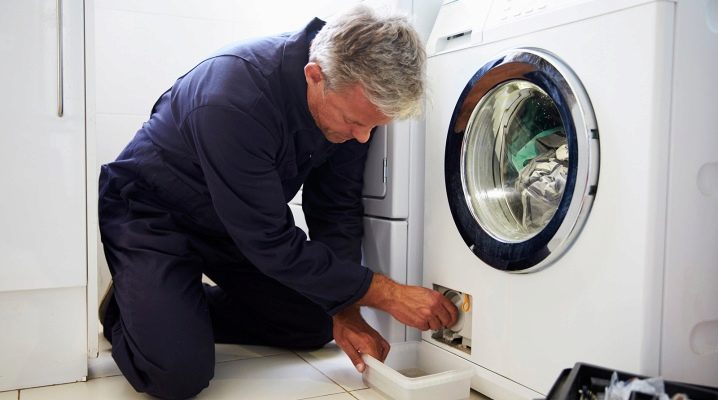
Any washing machine will serve its owner for a long time, if competently take care of it. First of all, you need to know that its uninterrupted operation directly depends on the state of the systems that filter water. Today, we will look in detail at the process of cleaning the drain filter in a washing machine, because it is the one that most often forms blockages that lead to malfunctions in work and even breakdown of much-needed household appliances.
Device drain system
In every modern washing machine there are two types of filter units:
- Input filter. Through it passes tap water entering the drum of the machine before each wash.
- Drain (he's a drainage, he's pumping) filter. It cleans the water after each work cycle.
When the machine has finished washing things, the waste dirty liquid must be removed from its drum, so that in the next stage you can rinse clean linen.
Used water from the drum of the machine enters a special rubber pipe, having the shape of an accordion. This is a small short pipe for draining water. The drain filter is connected directly to it. Further, water (purified from mechanical and other types of debris) from the nozzle enters the pump pump and its impeller. This is a kind of "engine" of the entire drain system.
The impeller (also known as the cochlea) creates pressure in the design of the “engine”, and thanks to this pressure, the water is pumped out and then directly into the sewage system, therefore, otherwise this drain filter is still pumping.
Purpose
Having understood the device of the entire drain system, it can be understood that the first and most important purpose of the drain filter is to protect the drain pump and its impeller from being clogged with dirt and small objects, which prevents the entire washing machine from breaking. The second (no less important) purpose is to prevent clogging of the sewer pipe.
Problems with clogging
The following malfunctions and faults in the washing machine may signal a blockage in the drain filter system:
- impossible to drain water from the tank;
- spin and rinse mode does not turn on;
- the wash cycle has stopped;
- drained drained waste water;
- An alphanumeric error code appears on the display of the washing machine.
Error codes
If a special code is displayed on the display screen of the machine that signals a malfunction, you can see the instructions for this household appliance. If the manual is lost and is not found, Below are the values of errors for different brands of washing machines and their meaning:
- Bosch - F03 - water does not drain;
- Ariston - F05 - a problem in the mechanism of the pump pump;
- Samsung - E 2 - either the drain filter is dirty or a pump error;
- Electrolux and Zanussi - E21, possibly E24, E23, E22 - does not work draining, the operation of draining the water takes too long;
- LG - OE - can not drain the water, defective filter or drain hose;
- Hansa, Candy, ASKO - E03 - water is not removed from the machine, the program has detected problems in the drain system - water passes slowly due to blockages or the operation cannot be performed at all, the cleaner of the water discharged from the machine or the entire drain system is clogged.
In these cases, an urgent need to check the status of the drain system. To do this, you need to determine which side of the machine the filter unit is located on.
Localization of the drain filter in different models of washing machines:
- Bosch, Siemens and Indesit washing machines are equipped with a drain device, which, as a rule, is located in the lower part of the right (behind the front panel);
- Electrolux and Zanussi cars place a filter behind the rear panel of the device;
- LG, Hotpoint, Ariston, Samsung, Whirlpool machines predominantly place the filter element at the very bottom (behind a small door).
Preparing to remove parts
Removing a blockage (that is, cleaning the drain filter) in a car when calling a paid wizard can cost its owner a substantial amount. On average, this is 1000-1500 rubles. Since such failures are not included in the warranty repair of this household appliances, you can try to solve the problem yourself. Beforehand it is necessary to carry out a preparatory stage before the cleaning process.
First of all, for this you need:
- turn off the power;
- prepare a large and dry, well-absorbing cloth or an old towel, because when removing the filter water will flow;
- if the filter is located behind an iron door that cannot be opened manually, you can make a flat screwdriver;
- prepare a flat drip tray.
The filter itself is a small (hollow inside) flask with a special mesh.
Removing the drain filter and the stages of its cleaning
Cleaning the pump filter should be done slowly, step by step:
- As mentioned above, you must first disconnect the machine from the network. It is very important for safety in the further actions. Next you need to shut off the water supply.
- We find the location of the drain filter, remove with a screwdriver or manually protecting its door or a special protective panel. This part is mounted on snaps or hooks. You can remove it in several ways: pry the upper part and pull it towards you, or sideways from right to left.
- Water is always present in the drain system (unlike the washing machine's tank). When unscrewing the drain filter, it can flow to the floor, so it is better to put a cloth under the typewriter or slightly lift it up by setting a flat bottom at the bottom.
If there is an additional emergency drain hose, you can remove it and let the accumulated water drain.
- In cars of brands AEG, LG, Electrolux, Zanussi, you first need to pull out the plug, and then the filter itself. To unscrew the drain filter, you need to gently turn it counterclockwise 40-60 degrees. Water will also flow from the hole.
- Then you can start cleaning the filter. It can contain a lot of garbage - clips, hair, nap, buttons, buckles, coins and even toothpicks. We clean the filter from debris, and then wipe it with a brush or a rag made of hard material.
- You can also look inside the machine, wipe the rest of the parts, check the blockages in the pump and the impeller - it should move freely if twisted.
- After completing the cleaning, you need to gently but firmly screw the filter back, and then do the rest of the manipulation to complete the work.
The main thing is that the filter clearly fits into its place - badly screwed, it will leak.
Prevention of drainage blockages
After the work done, you can breathe easier. The next 2 or 4 months the filter does not have to clean. Of course, it all depends on the frequency of washing and the material of contaminated things. Nevertheless, some masters recommend:
- clean the drain filter after each complete washing cycle, if woolen items or items with a large pile, as well as down pillows or blankets were loaded into the machine;
- use tap water softeners that do not allow scaling;
- henceforth, prevent small items from getting into the machine drum, check for this purpose clothes for the presence of decorative details and pockets;
- if the clothes are zipped, it is better to fasten them before washing;
- linen with metal or plastic inserts is better to wash in special covers.
What should I do if filter extraction is difficult?
If you have not cleaned the pump filter for a long time, it may “stick to it” and not be pulled out due to fat deposits, dirt, or stuck small debris.
In this case, you can use pliers, but so as not to break the plastic part. It is also permissible to clean the filter through the removed pump, if the pliers did not help. This is not very easy to do, since you need to remove the panel of the body of the machine, disconnect the wiring, disconnect the pipe and the hose, and then pull out the pump with the impeller. Then through the recess for the pipe you can clean the filter itself.
It is also possible to clean the filter through the pump hole, after removing the pump. This method requires detailed knowledge of the structure of the washing machine, so the amateur is better to contact the master of repair of household appliances.
Thus, in order to prevent the premature breakage of a thing so valuable in household use, it is necessary to regularly check its filtration system, and not to wait until a malfunction appears.
For more information on how to clean the drain filter in the washing machine, see the following video.
